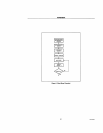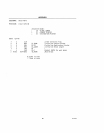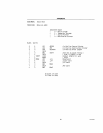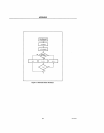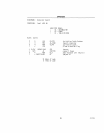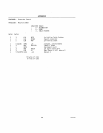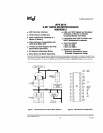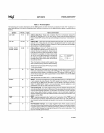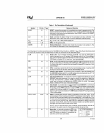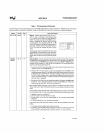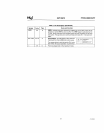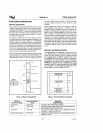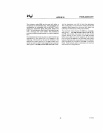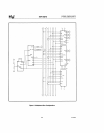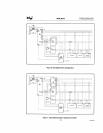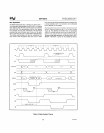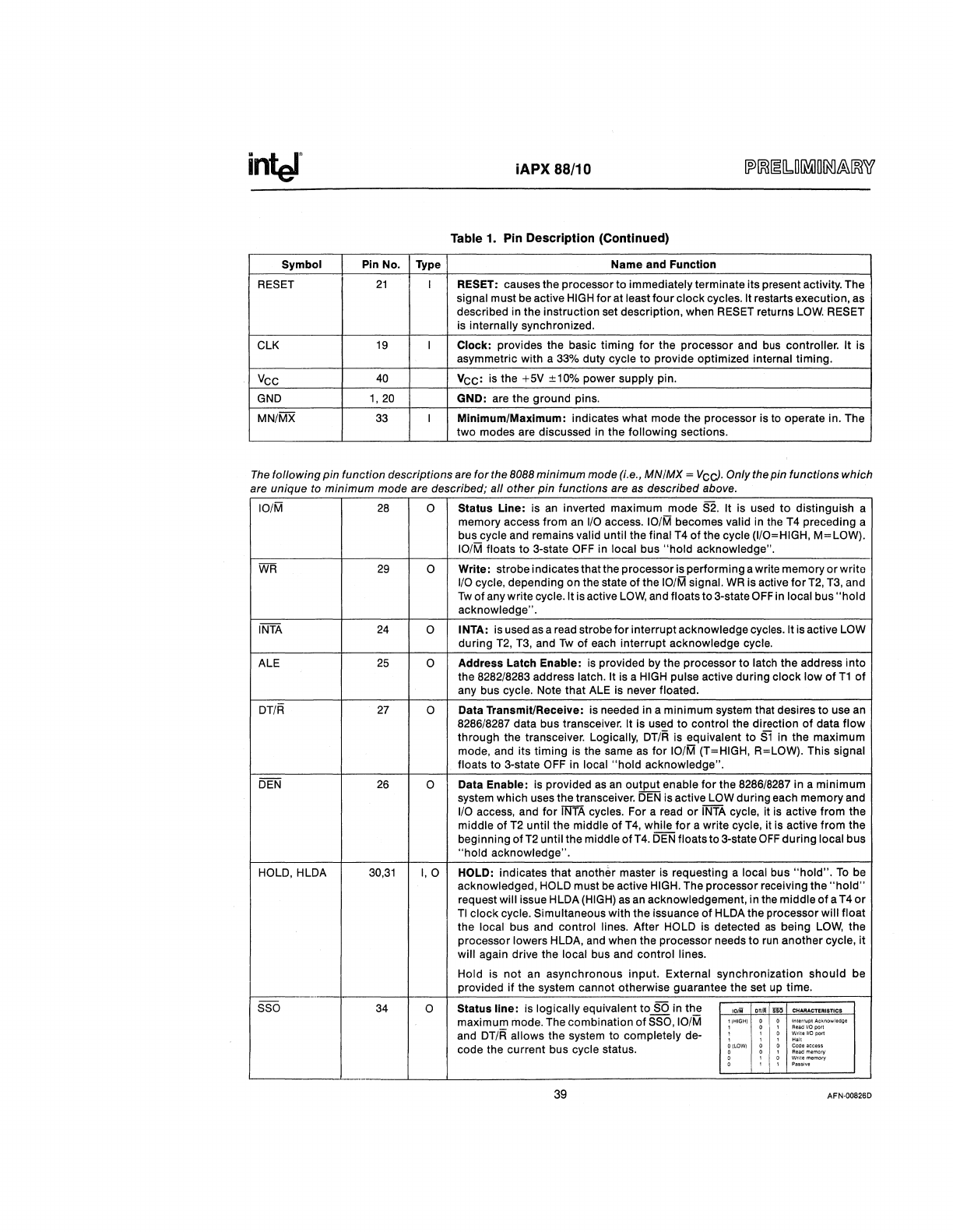
inter
iAPX 88/10
Table 1. Pin Description (Continued)
Symbol Pin No. Type Name and Function
RESET
21
I RESET: causes the processor to immediately terminate its present activity. The
signal must
be
active
HIGH
for at least
four
clock
cycles. It restarts execution, as
described
in
the instruction set description, when RESET returns
LOW.
RESET
is
internally synchronized.
eLK
19
I Clock: provides the basic timing
for
the processor and
bus
controller. It is
asymmetric with a
33%
duty cycle
to
provide optimized internal timing.
Vee
40
Vee:
is
the
+5V
±10% power supply pin.
GND
1,20
GND: are the ground pins.
MN/MX
33
I
Minimum/Maximum: indicates what mode the processor is to operate in. The
two modes are discussed
in
the following sections.
The
fol/owing pin function descriptions are for the 8088 minimum mode (i.e., MN/MX =
VecJ.
Only the pin functions which
are unique to minimum mode are described; al/ other pin functions are
as
described above.
10/M
28
0
Status
Line:
is
an
inverted maximum mode
S2.
It is used
to
distinguish a
memory access from
an
I/O
access. 10/M becomes valid
in
the T4 preceding a
bus
cycle and remains valid until the final
T4
of
the cycle (I/O=HIGH, M=LOW).
10/M floats
to
3-state OFF
in
local bus
"hold
acknowledge".
WR
29
0
Write: strobe indicates that the processor is performing a write memory
or
write
I/O
cycle, depending on the state of the 10/M signal.
WR
is active
for
T2,
T3, and
Tw
of
any write cycle. It is active
LOW,
and floats to 3-state
OFF
in local
bus"
hold
acknowledge" .
INTA
24
0
INTA:
is used
as
a read strobe
for
interrupt acknowledge cycles. It is active LOW
during
T2,
T3, and
Tw
of
each interrupt acknowledge cycle.
ALE
25
0
Address Latch Enable:
is
provided by the processor
to
latch the address into
the 8282/8283 address
latch. It is a
HIGH
pulse active during
clock
low
of
T1
of
any bus cycle. Note that ALE is never floated.
DT/R
27
0
Data Transmit/Receive: is needed in a minimum system that desires to use
an
8286/8287 data bus transceiver. It is used to control the direction
of
data flow
through the transceiver. Logically,
DT/R
is equivalent to
51
in the maximum
mode, and its timing is the same
as
for 10/M (T=HIGH, R=LOW). This signal
floats
to 3-state OFF in local
"hold
acknowledge".
DEN
26
0
Data Enable:
is
provided
as
an
output enable
for
the 8286/8287 in a minimum
system which uses the transceiver.
DEN
is active LOW during each memory and
I/O
access, and for
INTA
cycles. For a read
or
INTA
cycle, it is active from the
middle
of
T2
until the middle
of
T4,
while
for
a write cycle, it is active from the
beginning
of
T2
until the middle
of
T4.
DEN
floats to 3-state
OFF
during
local bus
"hold
acknowledge".
HOLD,HLDA
30,31
1,0
HOLD: indicates that another master is requesting a local bus
"hold".
To
be
acknowledged,
HOLD must
be
active HIGH. The processor receiving the
"hold"
request will issue HLDA (HIGH)
as
an
acknowledgement, in the middle
of
a T4
or
TI
clock cycle. Simultaneous with the issuance
of
HLDA the processor will float
the local bus and control lines. After HOLD is detected
as
being
LOW,
the
processor lowers HLDA, and when the processor needs to
run
another cycle, it
will again drive the local bus and control lines.
Hold
is
not
an
asynchronous input. External synchronization should be
provided
if
the system cannot otherwise guarantee the set
up
time.
SSO
34
0
Status
line:
is logically equivalent to
SO
in
th~
101M
DTifi
§SO
CHARACTERISTICS
maximum mode. The combination
of
SSO,
10/M
:
,"'0><)
1!
:
Interrllpt
Ac,nowledge
Read
IIOporj
and DT/R allows the system to completely de-
~~::e
110
port
code the current bus cycle status.
~
<,OWl
,
CodaaccaS$
,
Read
memory
0
,
Wntememory
,
Passive
-
39
AFN·QOB26D



